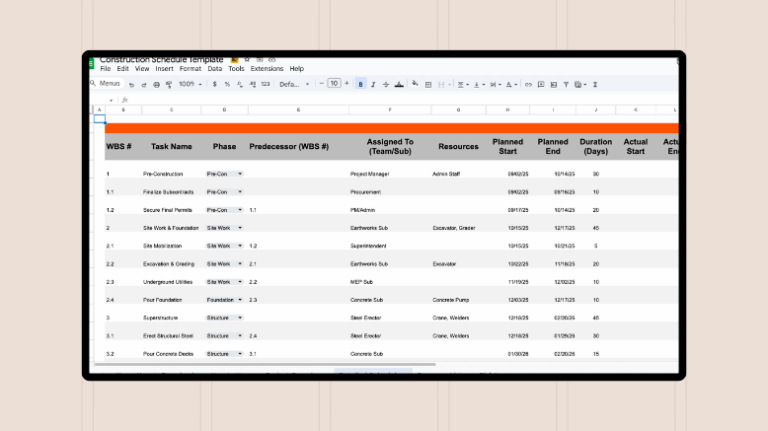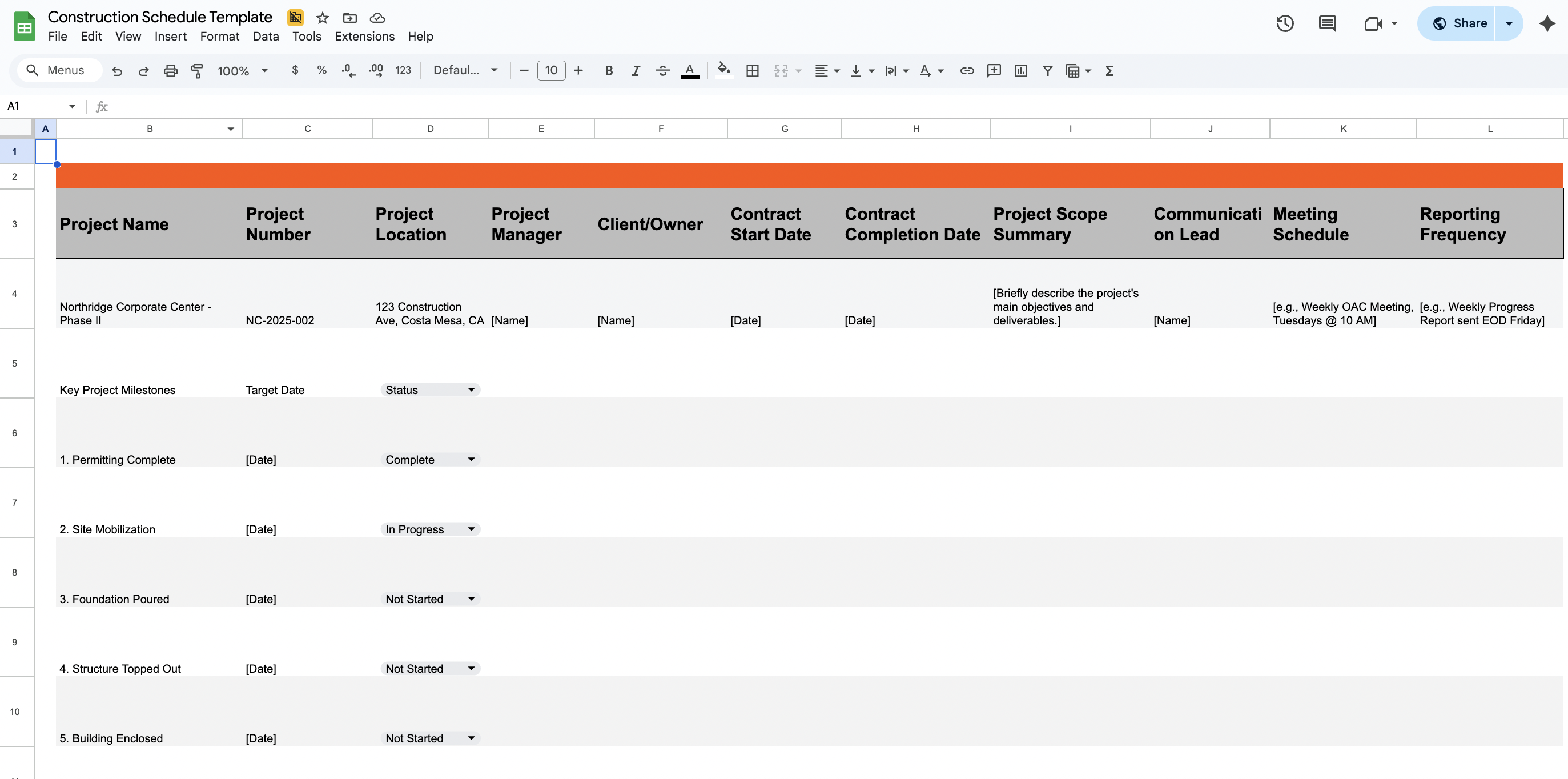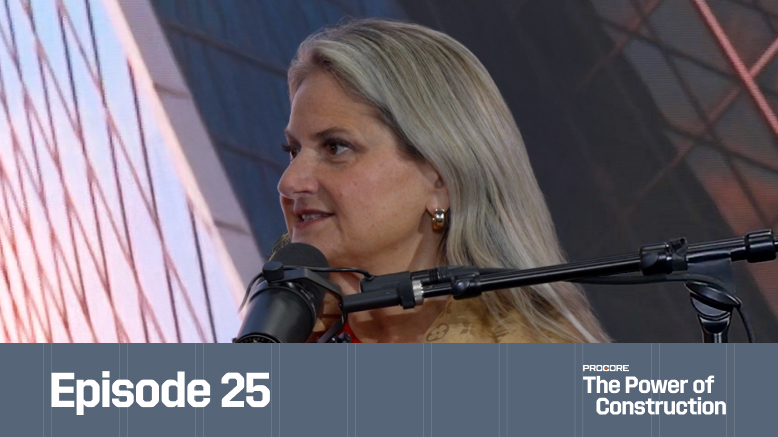— 7 min read
How to Create a Construction Schedule Template


Last Updated Oct 23, 2025

Kristen Frisa
Contributing Writer
111 articles
Kristen Frisa is a contributing writer for Procore. She also contributes to a variety of industry publications as a freelance writer focused on finance and construction technology. Kristen holds a Bachelor of Arts in Philosophy and History from Western University, with a post-graduate certificate in journalism from Sheridan College. She lives in Ontario, Canada.

James Hamilton
Writer & Producer
83 articles
James Hamilton is a writer based in Brooklyn, New York with experience in television, documentaries, journalism, comedy, and podcasts. His work has been featured on VICE TV and on The Moth. James was a writer and narrator for the show, VICE News Tonight, where he won an Emmy Award and was nominated for a Peabody Award.

Ben Ashburn
Staff Trainer & Program Manager
22 articles
Ben Ashburn is a Senior Construction Education Trainer at Procore. After a successful career as a construction estimator — working his way up from estimating manager to senior estimator — Ben has spent the most recent part of his career in construction sharing his skills with other as a construction educator. Ben has an extensive background in construction education: He has been an assistant professor in the Department of Construction Science at Texas A&M, and lectured about estimating, scheduling, management, and other related construction topics at Murray State University. He has been a construction training and learning development partner with Procore since 2019.
Last Updated Oct 23, 2025

Construction schedules are central to effective project management, helping to guide each to optimize the time, resources and budget available. Creating schedules can be pretty complex, involving the coordination of multiple teams, managing available equipment and labor and anticipating potential delays.
A well-designed construction template can help to streamline the process and provide a consistent framework to manage these challenges more effectively. A template can significantly smooth the scheduling process and keep a project on track and executed with precision.
This article outlines key steps and considerations for developing a construction schedule template. A customizable, downloadable schedule template is included below.
Table of contents
What is a construction schedule?
A construction schedule is a detailed plan that outlines all the tasks, timelines, resources and milestones necessary to complete a construction project. It helps construction managers track progress and make sure work is completed in good time and lets everyone involved know which tasks need to be done when.
Construction schedules enhance coordination among various stakeholders, facilitate good resource allocation and help mitigate risks by identifying potential delays ahead of time.
Types of Construction Schedules
Different types of construction schedules serve various purposes and are suitable for different stages or sizes of projects.
Critical Path Method (CPM)
The Critical Path Method (CPM) identifies the longest sequence of tasks in a construction project, determining the shortest possible project duration.
CPM helps project managers allocate resources efficiently and prioritize efforts to avoid delays by focusing on critical tasks that directly impact the project timeline.
It can be particularly beneficial for complex projects with interdependent tasks, as it highlights potential bottlenecks and aids in proactive planning.
Program Evaluation and Review Technique (PERT)
The Program Evaluation and Review Technique (PERT) is a statistical tool construction managers can use to analyze and represent the tasks involved in completing a project.
PERT involves three different time estimates — "optimistic," "pessimistic" and "most likely" — to calculate an expected completion time, and gives probabilities for project timelines.
This method can helpful on projects with high uncertainty, as it allows managers to plan for various scenarios and adjust strategies accordingly.
Line of Balance (LOB)
Line of Balance (LOB) is a scheduling method managers use in repetitive projects, such as residential housing developments or production lines. It visually maps out the progress of different tasks over time, ensuring that each stage of the project aligns with the others to maintain a steady workflow.
LOB helps identify inefficiencies and creates consistent output, minimizing idle time and maximizing productivity.
Last Planner system (LPS)
The Last Planner System (LPS) emphasizes active participation from all team members in the scheduling process to improve workflow reliability. LPS involves those who are directly responsible for executing tasks, encouraging realistic planning and a system of continuous feedback — which can help identify and resolve constraints proactively.
This system can improve communication and trust among team members, leading to more predictable outcomes and less waste throughout the construction process.
Gantt Charts
Gantt charts are widely used in construction scheduling because they visually represent tasks over time. They show the start and finish dates of each task, helping project managers see the entire project timeline at a glance.
Gantt charts are ideal for complex projects with multiple overlapping tasks.
Milestone Tracking
Milestone tracking focuses on key deliverables and goals within a project. By highlighting significant achievements, such as the completion of a building phase or the delivery of materials, milestone tracking helps keep the project on course.
This type of schedule is especially useful for monitoring progress and making sure critical deadlines are met.
Weekly Plans
Weekly plans break down the construction schedule into weekly tasks, providing a more granular view of the project. This approach is beneficial for managing daily activities and quickly addressing any issues that arise.
Weekly plans are perfect mini-schedules for on-site management, so that the team knows what needs to be done each day.
Stay updated on what’s happening in construction.
Subscribe to Blueprint, Procore’s free construction newsletter, to get content from industry experts delivered straight to your inbox.

The Importance of Construction Schedule Templates
Construction schedules can be complex, demanding and require a difficult blend of precision and adaptability.
A construction schedule template standardizes the planning process. Using a consistent framework that can be adapted for different projects saves time, improves efficiency, increases clarity for stakeholders and reduces the potential for errors.
Templates also improve collaboration, as they create a shared system for stakeholders to work together and understand how their contributions fit into the larger project.
Templates create a way for schedules to become tools for improving future projects. By introducing consistency and standardization, templates create reliable data on how projects get done, which milestones are hit and the efficacy of scheduling.

Ben Ashburn
Staff Trainer & Program Manager
Procore Technologies
How a Template Can Improve Construction Scheduling
Construction schedule templates provide a consistent framework, making it easier to create detailed schedules quickly. They improve time management by offering a clear timeline for each task, reducing the likelihood of delays.
Here are some ways a template can help in construction scheduling.
Standardization
Templates offer a uniform structure that helps teams maintain consistency across different projects.
Efficiency
By using a pre-designed template, project managers can save time that would otherwise be spent creating schedules from scratch.
Communication
Templates facilitate clearer communication among stakeholders by providing a common format for presenting schedules and timelines.
Adaptability
A well-designed template is flexible enough to accommodate changes and updates as the project progresses.
Collaboration
With a template, team members can easily collaborate on scheduling tasks, as it provides a shared platform for input and updates gathered from those directly involved in task execution.
Risk Management
Templates with sections for identifying potential risks and assigning contingency plans can help anticipate challenges and prepare strategies to mitigate them.
Elements of a Successful Construction Schedule Template
A construction schedule template typically includes several key components for comprehensive project planning and execution.
Project Overview
A brief summary of the project, including objectives, scope and key deliverables
Task List
A detailed list of all tasks required to complete the project, broken down into phases or categories
Timeline
Start and finish dates for each task, often represented visually through Gantt charts or other visual timelines
Dependencies
Identification of tasks that are dependent on the completion of others, helping to understand the sequence of activities
Milestones
Key dates or achievements that mark significant points in the project timeline
Resource Allocation
Information on the resources needed for each task, including labor, materials and equipment
Responsibilities
Assignment of team members or departments responsible for each task
Progress Tracking
Sections for regularly updating task status and noting any changes or delays
Risk Management
Identification of potential risks and contingency plans to address them
Budget Overview
An outline of the project budget, including cost estimates for tasks and resources
Communication Plan
Details on how updates and information will be communicated to stakeholders
Notes and Comments
Space for additional information, observations or instructions related to specific tasks or phases
Construction template components work together to provide a clear and organized framework for managing a construction project, bettering both efficiency and communication.
Free Download
Construction Schedule Template
Download this simple, customizable schedule template to use as a starting point for any project.
- Free starter template
- Fully customizable
- Created by construction professionals


Create effective schedules using a template.
A well-crafted construction schedule is indispensable for any construction project. And no matter which scheduling method a construction team uses, it can be challenging to manage such a large number of tasks happening at the same time.
Construction management platforms can help keep all team members — from site employees to executives and owners — all apprised of where the schedule is at any given time. Software can issue alerts to warn managers of coming conflicts or when the schedule gets behind, so that they can work proactively to set things right. With a templated schedule at hand and modern tools equipped, construction teams can stay on task and on track easier than ever.
By understanding the different types of schedules and using modern tools and templates, construction owners and general contractors can work toward quality projects that are completed on time, every time.
Was this article helpful?
Thank you for your submission.
0%
0%
You voted that this article was . Was this a mistake? If so, change your vote
Scroll less, learn more about construction.
Subscribe to The Blueprint, Procore’s construction newsletter, to get content from industry experts delivered straight to your inbox.
By clicking this button, you agree to our Privacy Notice and Terms of Service.
Thank you!
You’re signed up to receive The Blueprint newsletter from Procore. You can unsubscribe at any time.
Categories:
Written by

Kristen Frisa
Contributing Writer | Procore
111 articles
Kristen Frisa is a contributing writer for Procore. She also contributes to a variety of industry publications as a freelance writer focused on finance and construction technology. Kristen holds a Bachelor of Arts in Philosophy and History from Western University, with a post-graduate certificate in journalism from Sheridan College. She lives in Ontario, Canada.
View profile
James Hamilton
Writer & Producer
83 articles
James Hamilton is a writer based in Brooklyn, New York with experience in television, documentaries, journalism, comedy, and podcasts. His work has been featured on VICE TV and on The Moth. James was a writer and narrator for the show, VICE News Tonight, where he won an Emmy Award and was nominated for a Peabody Award.
View profileReviewed by

Ben Ashburn
Staff Trainer & Program Manager | Procore Technologies
22 articles
Ben Ashburn is a Senior Construction Education Trainer at Procore. After a successful career as a construction estimator — working his way up from estimating manager to senior estimator — Ben has spent the most recent part of his career in construction sharing his skills with other as a construction educator. Ben has an extensive background in construction education: He has been an assistant professor in the Department of Construction Science at Texas A&M, and lectured about estimating, scheduling, management, and other related construction topics at Murray State University. He has been a construction training and learning development partner with Procore since 2019.
View profileExplore more helpful resources

Defending Against Financial & Legal Risks on Megaprojects
The construction industry has seen marked growth in megaprojects. Some experts classify any project over $500 million as a megaproject, while others argue that the build needs to be $1...

Unlocking Project Intelligence: Moving from Raw Data to Actionable Insights
The construction industry faces a wide range of challenges, from ongoing labor shortages to frequent cost overruns. But some the biggest hurdles all stem from unpredictability. The general contractors (GCs)...

Who is accountable for innovation in construction?
Everyone says construction needs to innovate—but no one agrees on who’s actually responsible for making it happen. Is it the owner? The builders? The tech vendor? Or is innovation everyone’s...

Integrated Project Delivery in Practice: A Framework for Collaboration
On construction projects, traditional delivery methods put different stakeholders in their own silos. While the design team feeds drawings and specifications to the general contractor (GC), the GC’s expertise in...
Free Tools
Calculators
Use our calculators to estimate the cost of construction materials for your next project.
Templates
Find a template to help you with your construction project tasks.
Material Price Tracker
Get the latest U.S. retail prices and view historical trends for common building materials.
Glossary
Explore key terms and phrases used in the industry.
